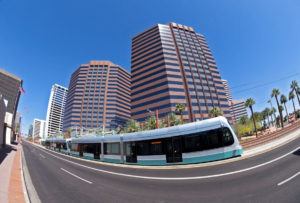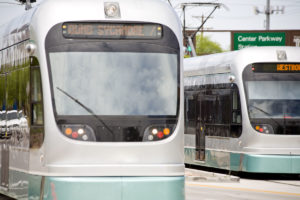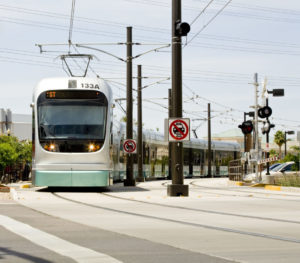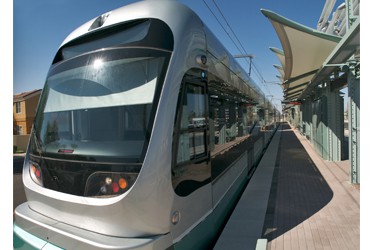 The Greater Phoenix Chamber advocates for the development and maintenance of a balanced and cost-efficient transportation system that involves all modes of transportation.
The Greater Phoenix Chamber advocates for the development and maintenance of a balanced and cost-efficient transportation system that involves all modes of transportation.
As the voice of business, the Chamber supports the region’s groundbreaking light rail system that has connected cities and communities since the initial opening in 2008.
As Mayor Kate Gallego shared in her inaugural State of the City Address, “light rail moves more than people, it moves our economy.” Valley Metro’s light rail system, which connects Phoenix, Tempe, and Mesa, covers 26 miles with 35 stations and supports approximately 16.5 million riders annually.
The light rail system enhances the region’s connectivity by increasing mobility, encouraging more walkable communities, and providing an additional public transit option for residents and tourists.
While light rail construction can be a temporary challenge for existing businesses, Valley Metro and their partners work diligently to assist those businesses so that they thrive during the construction phase.
In the past decade that the system has been in operation, the region has seen approximately $11 billion in actual construction activity along the rail corridor in all three cities.
With the Transportation 2050 plan, regional leaders aim to expand bus routes and operational hours, developing and increasing the miles and routes of high-capacity transit such as light rail and bus rapid transit, and adding needed funds to street maintenance. Specifically, Transportation 2050 would add 42 miles of light rail in the City of Phoenix and increase the number of light rail stations.
In May, the Greater Phoenix Chamber’s Board of Directors voted to oppose the “Building a Better Phoenix Act,” which is also known as Prop 105.
The proposed ballot initiative would amend the Phoenix City Charter to terminate all planned expansions of light rail  projects, and not expend any funds in the furtherance of light rail extensions or other fixed rail line transit systems constructed on or after August 27, 2018. Additionally, the Act redistributes revenues designated for light rail extensions for infrastructure projects within the City.
projects, and not expend any funds in the furtherance of light rail extensions or other fixed rail line transit systems constructed on or after August 27, 2018. Additionally, the Act redistributes revenues designated for light rail extensions for infrastructure projects within the City.
This initiative is specific to the City of Phoenix; however, it could have repercussions on the future of transportation funding in the region. The redistribution of funds could ultimately result in a loss of more than $5 billion in federal and regional funds to other cities in this region and throughout the U.S.
The Building a Better Phoenix Act was developed from the opposition of a small number of residents and businesses who oppose the south central light rail extension. Although drafters sought to target the south central line expansion specifically, the Act instead extends to all Phoenix city rail projects and extensions.
 The Act threatens to damage the value that light rail provides to the Greater Phoenix region and threatens to diminish Phoenix’s economic progress.
The Act threatens to damage the value that light rail provides to the Greater Phoenix region and threatens to diminish Phoenix’s economic progress.
During a recent Find Your PHX tour, a new senior executive moving to Phoenix was excited for the accessibility light rail provides.
Light rail is an important component of a multi-modal transportation system. In Phoenix, light rail has supported more than $7 billion of economic activity already, and it is important to keep that momentum moving forward. Not only will light rail connect the region’s students and workforce, but it is essential in keeping the Greater Phoenix region competitive with other markets.
unshaven girls займ на киви с 18 летзайм центрофинансонлайн займ без проверок частный займ в москве личная встречаслова займбыстро займ



You must be logged in to post a comment.